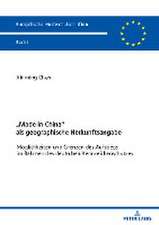Copyright's Excess: Money and Music in the US Recording Industry
Autor Glynn Lunneyen Limba Engleză Paperback – 11 apr 2018
Toate formatele și edițiile
| Toate formatele și edițiile | Preț | Express |
|---|---|---|
| Paperback (1) | 296.85 lei 38-45 zile | |
| Cambridge University Press – 11 apr 2018 | 296.85 lei 38-45 zile | |
| Hardback (1) | 492.23 lei 6-8 săpt. | |
| Cambridge University Press – 11 apr 2018 | 492.23 lei 6-8 săpt. |
Preț: 296.85 lei
Nou
Puncte Express: 445
Preț estimativ în valută:
56.80€ • 59.31$ • 47.01£
56.80€ • 59.31$ • 47.01£
Carte tipărită la comandă
Livrare economică 31 martie-07 aprilie
Preluare comenzi: 021 569.72.76
Specificații
ISBN-13: 9781316632796
ISBN-10: 1316632792
Pagini: 248
Ilustrații: 46 b/w illus. 12 tables
Dimensiuni: 151 x 229 x 14 mm
Greutate: 0.37 kg
Editura: Cambridge University Press
Colecția Cambridge University Press
Locul publicării:New York, United States
ISBN-10: 1316632792
Pagini: 248
Ilustrații: 46 b/w illus. 12 tables
Dimensiuni: 151 x 229 x 14 mm
Greutate: 0.37 kg
Editura: Cambridge University Press
Colecția Cambridge University Press
Locul publicării:New York, United States
Cuprins
1. Introduction; 2. The (surprisingly weak) economic case for copyright; 3. Copyright and revenue in the recording industry; 4. Measuring music output; 5. The search for a correlation: was more money associated with more or better music?; 6. More money meant less music; 7. Rationalizing copyright.
Recenzii
'Lunney convincingly shows that an intuitively plausible account of copyright's dose-response effect on music production is inaccurate, and that the economic story is far more complicated. By asking us to focus on the marginal artists, not the greatest hitmakers, he productively challenges copyright maximalism as well as some varieties of minimalism. Anyone interested in the music ecosystem, or in the economics of creativity, will learn a lot from this book.' Rebecca Tushnet, Frank Stanton Professor of First Amendment Law, Harvard Law School
'A must read for anyone interested in the relationship between copyright law and good music. Lunney combines the firepower of a Ph.D. economist, the incisive thinking of a trained lawyer, and the passion of a music lover in a book that is both eminently readable and scholarly.' Paul J. Heald, Richard W. and Marie L. Corman Research Professor of Law, University of Illinois College of Law
'Glynn Lunney presents a comprehensive history of the economics of modern music, all pointing to a striking conclusion: the more money musicians make, the less music they make. His data upends the traditional copyright story. Along the way, we learn any number of facts about the music world, including which artist has the most top-100 hits in the first decade of their career (hint: the Beatles are number 2). Highly recommended.' Mark A. Lemley, William H. Neukom Professor, Stanford Law School
'Through patient and inventive analysis of industry data, Glynn Lunney shows that more copyright does not produce more or better music – and that in fact it may produce less. It may be that the proponents of ever-increasing copyright will remain unconvinced. But they will have to confront Lunney's work.' Christopher Jon Sprigman, New York University School of Law
'Copyright's Excess is foundational work in the economics of intellectual property.' Jotwell
'A must read for anyone interested in the relationship between copyright law and good music. Lunney combines the firepower of a Ph.D. economist, the incisive thinking of a trained lawyer, and the passion of a music lover in a book that is both eminently readable and scholarly.' Paul J. Heald, Richard W. and Marie L. Corman Research Professor of Law, University of Illinois College of Law
'Glynn Lunney presents a comprehensive history of the economics of modern music, all pointing to a striking conclusion: the more money musicians make, the less music they make. His data upends the traditional copyright story. Along the way, we learn any number of facts about the music world, including which artist has the most top-100 hits in the first decade of their career (hint: the Beatles are number 2). Highly recommended.' Mark A. Lemley, William H. Neukom Professor, Stanford Law School
'Through patient and inventive analysis of industry data, Glynn Lunney shows that more copyright does not produce more or better music – and that in fact it may produce less. It may be that the proponents of ever-increasing copyright will remain unconvinced. But they will have to confront Lunney's work.' Christopher Jon Sprigman, New York University School of Law
'Copyright's Excess is foundational work in the economics of intellectual property.' Jotwell
Notă biografică
Descriere
Tests copyright's fundamental premise that more money will increase creative output using the US recording industry from 1962–2015.



























